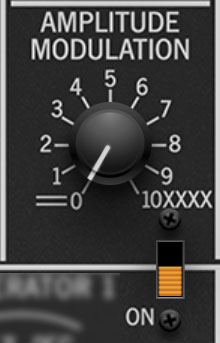In this section, we'll talk about VCA-related voice panel functions. VCA is an acronym for "voltage-controlled amplifier." A good analogy of VCA functionality is a faucet that regulates signal volume, with the knob amount regulated by a control voltage. Most commonly, this voltage comes from an envelope generator in order to shape individual notes, but VCA's can be controlled by other sources such as LFO's, audio-frequency oscillators, and more.

Keyboard Volume Balance- As its name implies, this control affects the balance of note volumes across the keyboard. At a setting of zero, note volumes will be the same across the entire keyboard range. If the knob is turned left, lower notes become louder and higher notes become softer. Conversely, turning knob up from center lowers the volume of low notes and increases the volume of high notes.
Signal Out jack- This a "direct out" of audio from the panel, and can be routed to any of PS-3300's audio or control input. Plugging a patch cord into the Signal Out jack does not affect the hardwired Master panel Signal Mixer routing, but you can turn down the appropriate Signal Mixer knob if you only want the Signal Out jack audio.
The LED above the Signal Out jack glows whenever the panel is producing audio. These were added for, "Is this thing making noise?," convenience.
Amplitude Modulation

Amplitude Modulation knob and routing switch- Moving a little further down the panel, Amplitude Modulation allows Mod Generator 1 to modulate audio level (make sure the orange switch between the sections is in the down position). At slower mod speeds, this is useful for conventional undulating-level tremolo effects. When the Mod Generator 1 is set to faster speeds, you'll hear ring modulator-type special effects (try experimenting with different Mod Generator waveforms as well).